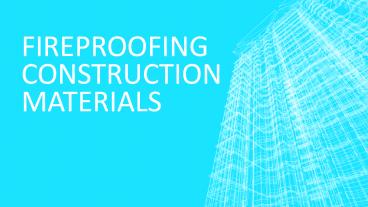Fireproofing Construction materials - PowerPoint PPT Presentation
Title:
Fireproofing Construction materials
Description:
It is passive fire protection measure that aims to make materials or structure more resistant to fire or using such materials in the construction of structures. This application of fireproof materials or application of different methods for protection against fire gives the structure a fire-resistance rating. – PowerPoint PPT presentation
Number of Views:745
Title: Fireproofing Construction materials
1
FIREPROOFING CONSTRUCTION MATERIALS
2
- No building material is perfectly fire proof.
Every building contains some materials (such as
furniture, clothing, eatables etc.) which can
either easily catch fire or which are vulnerable
to fire. - A wider interpretation of fire safety may be
deemed to cover the following aspects - Fire prevention and reduction of number of
outbreaks of fire, ? Spread of fire, both
internally and externally, - Safe exit of any and all occupants in the event
of an outbreak of fire, Fire extinguishing
apparatus.
3
Properties of Fire Resisting Materials
- An ideal fire resisting material should possess
the following characteristics - The material should not disintegrate under the
effect of great heat. - The expansion of the material due to heat should
not be such that it leads to instability of the
structure of which it forms a part. - The contraction of the material due to sudden
cooling with water (during fire extinguishing
process) after it has been heated to a high
temperature should not be rapid.
4
- In relation to fire, building materials can be
divided into two types - Non-combustible materials
- These materials do not contribute to the growth
or spread of fire, but are damaged and decomposed
when high temperatures are reached. Examples of
non- combustible materials are stones and
bricks, concrete, clay products, metal, glass
etc. - Combustible materials
- They are those which, during fire, combine
exothermically with oxygen, resulting in
evolution of lot of heat and giving rise to flame
or glow. Such materials burn and also contribute
to the growth of fire. Examples of these
materials are wood and wood products, fibre
board, straw board etc.
5
Fire Resisting Properties of Common Building
Materials
- Stone
- Stone is a non-combustible building material and
also a bad conductor of heat and does not
contribute to the spread of fire. - It is a bad fire-resisting material since it is
liable to disintegrate into small pieces when
heated and suddenly cooled, giving rise to
failure of structure. Granite, on exposure to
severe heat, explodes and disintegrates. - Limestone is the worst, since it is easily
crumbled even under ordinary fire. - Sand stone of compact composition (fine grained)
can, however, stand the exposure to moderate fire
without serious cracks. - In general, the use of stone in a fire-resisting
construction should be restricted to a minimum.
6
- Bricks
- Brick is a poor conductor of heat. First class
bricks moulded from good clay can stand exposure
to fire for a considerable length of time, upto
temperatures of about 1200C. - Brick masonry construction, with good mortar and
better workmanship, is the most suitable for
safeguarding the structure against fire hazards. - Asbestos cement
- It is formed by combining fibrous asbestos with
Portland cement. - It has low coefficient of expansion and has
property of incombustibility. - Asbestos cement products are largely used for
construction of fire-resistant partition walls,
roofs, etc.
7
- Concrete
- The behavior of concrete during exposure to heat
varies with the nature of coarse aggregate and
its density, and the quality of cement. - Aggregates expand on heating while ordinary
cement shrinks on heating. - These two opposite actions may lead to spalling
of the concrete surface. Aggregates obtained from
igneous rocks containing higher calcareous
content, tend to crack more while the aggregates
like foamed slag, cinder and bricks are better. - Concrete offers a much higher resistance to fire
than any other building material. Reinforced
concrete structures can withstand fire lasting
for several hours with a temperature of 1000C
without serious damage
8
- Steel
- Though steel is non-combustible, it has very low
fire resistance, since it is a good conductor of
heat. - During fire, it gets heated very soon, its
modulus of elasticity reduces and it looses its
tensile strength rapidly. - Unprotected steel beam sags and unprotected
columns or struts buckle, resulting in the
collapse of structures. - If the surface paint on these steel components
is not fire resistant structure, it is essential
to protect structural steel members with some
coverings of insulating materials like brick,
terra-cotta, concrete etc.
9
- Aluminium
- It is very good conductor of heat. It has very
poor fire-resistant properties. - Its use should be restricted to only those
structures which have very fire risks - Cast-iron and wrought iron
- Cast iron behaves very badly in the event of
fire. - On sudden cooling, it gets contracted and breaks
down into pieces or fragments, giving rise to
sudden failure. - It is rarely used in fire- resistant building
unless suitably covered by bricks, concrete etc. - Wrought iron behaves practically in the same way
as mild steel.
10
Fire-Proof Companies in UAE
- Steel House Construction Co. LLC
- PO Box 3346, SHARJAH, UAE
- Telephone (971) 6-544 9552
- Fax No (971) 6-544 9553
- Email info_at_steelhousellc.com
- Web www.steelhousellc.com































